Fruit Flies
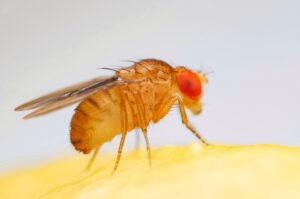
Appearance: Very small flies that are about 1/8 inch in length, including the wings. They are among the smallest flies found in homes. A distinct characteristic of a Fruit Fly is its bright red eyes. The body is usually a light yellow to tan color.
Source: Homeowners typically encounter Fruit Flies in and around their kitchens and near garbage storage. Fruit Flies hover over decaying fruit or fermenting materials like leftover beer or soft drinks.
Elimination: Fruit Flies are attracted to the smell of vinegar, and usually, once in vinegar, they cannot fly out. One way to attract and trap fruit flies is to get a bottle of apple cider vinegar, cover the top with plastic wrap, and poke a hole in the top for the fly to enter through. Putting a bit of dish soap in the vinegar also helps prevent the fly from flying.
Phorid Flies
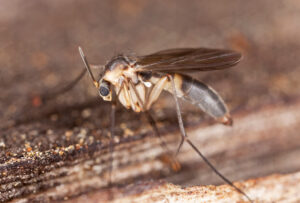
Appearance: Small flies that grow up to 1/8 inch in length. They are a little darker than Fruit Flies in color, tan to dark brown, and lack bright red eyes. This fly’s most prominent feature is its humpback body shape. The Phorid Fly also has the distinctive feature of running rapidly across surfaces instead of flying immediately when disturbed.
Source: Typically found breeding in poorly stored meats, damaged food containers, damp organic materials, and organic-based glues and paints. These types of flies are located in kitchen areas, around plumbing, garbage containers, crawl spaces, and basements.
Elimination: Removing the source is always a good start when fighting Phorid Flies. Clean the drains in your home to remove any standing organic debris. Close food containers and garbages. Fix any leaks causing excess moisture in your home.
Drain Flies
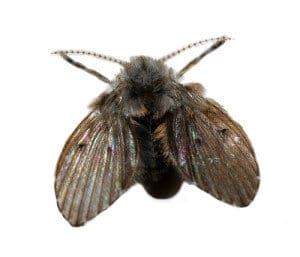
Appearance: Small black or brown flies, usually about 1/8 inch long. The key identifying trait of this fly is the unique pattern of wing veins. If crushed, the flies leave a powdery smudge.
Source: Drain Flies breed in drains, sewers, septic tanks, and soil that has been contaminated with sewage.
Elimination: Using a sanitation product like Invade Bio Drain or even Drano will help destroy the Drain Flies’ breeding area if they are breeding in the drain.
Fungus Gnats
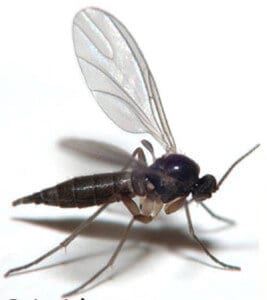
Appearance: Generally small and often tiny flies with long legs and long thin, and veiny wings.
Source: Dark, moist areas are breeding grounds for fungus and, in turn, for Fungus Gnats. The larvae feed on fungus growing in soil and moist organic matter. Damage from these gnats most often occurs in greenhouses or in plant beds.
Elimination: To eradicate Fungus Gnats, you must remove the fungus source from your home or yard. Don’t stop looking once you have found one breeding source; in most cases, several breeding sources will be present. Keep the source area lit and dry to prevent fungus from growing and spreading.
Sphaerocerid Flies
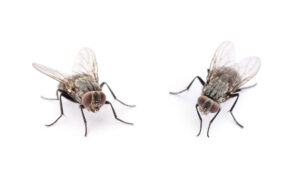
Appearance: Small black flies with a thicker section at the very top of the legs. Also called “dung flies” because they may breed in animal manure.\
Source: Often found breeding in animal manure and in poultry houses. Also may feed on organic decaying matter, meaning they may be found in the same areas as Phorid and Fruit Flies.
Elimination: Remove any decaying matter from the area. Clean the drain with a bio-drain gel if found in a drain source.
Cheese Skippers

Appearance: Black and shiny flies with bronze tints about 3/16 inches long. Reddish brown eyes and slightly iridescent wings. The Cheese Skipper has sudden snapping movements, which may cause them to “skip” as far as 10 inches.
Source: Often found on cheese and meats. They can also get trapped in grease and food in cracks in equipment. When inspecting for Cheese Skippers, remember that the breeding source must be moist.
Elimination: Sanitation is important for the containment and eradication of this fly. All surfaces should be entirely cleaned to remove all grease, crumbs, cheese, and meat scraps. Fogging with pyrethrin compounds is also recommended for killing adult Cheese Skippers.
How to Get Rid of Different Types of Flies with proof.
Dealing with flies in your living space can be a nuisance, but tackling them doesn’t have to be complicated. Whether you’re facing fruit flies, house flies, drain flies, cluster flies, or gnats, you can apply a handful of versatile strategies to keep these pests in check.
- 1. Sanitation: Keep your living spaces clean and tidy to discourage all types of flies. Dispose of overripe fruits, vegetables, and trash promptly.
- 2. Prevention: Seal gaps and cracks in windows, doors, and walls to prevent flies from entering. Ensure windows and doors have screens to keep flies out.
- 3. Traps and Control: Use vinegar traps, apple cider vinegar, and dish soap to attract and trap flies. Employ sticky traps to catch adult flies, like fruit flies and gnats.
- 4. Drain Management: Clean drains regularly using vinegar and baking soda to prevent drain flies. Cover drains and pour a mixture of bleach and water to eliminate drain fly larvae.
- 5. Plant Care: Reduce indoor plants’ overwatering to discourage gnats’ breeding. Allow the top layer of plant soil to dry before watering again.
- 6. Exterior Treatment (for Cluster Flies): Apply residual insecticides around windows and entry points in late summer or early fall. Seal gaps and cracks on the exterior of your home to prevent cluster flies.
Remember, a combination of these tactics tailored to the specific types of flies can help you effectively manage and reduce fly populations in and around your home.
If you need help getting rid of flies, we cover flies and more than 30 other bugs, plus rodents like mice, with our Pest Free Guarantee™ seasonal service plan.

